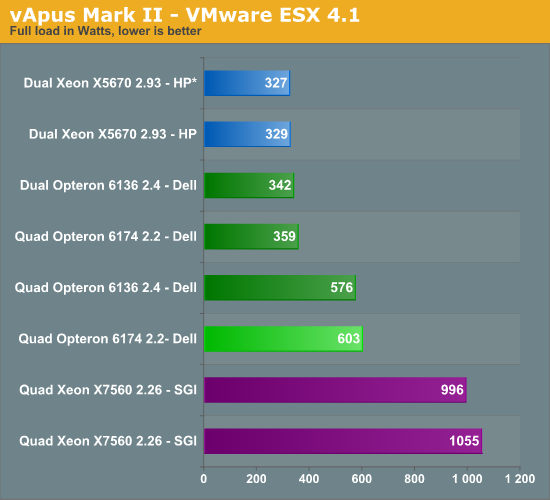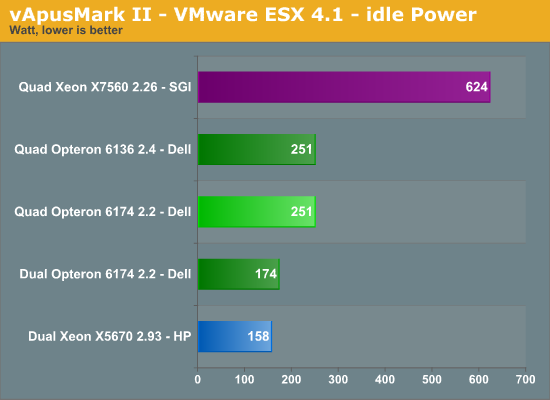Server Clash: DELL's Quad Opteron DELL R815 vs HP's DL380 G7 and SGI's Altix UV10
by Johan De Gelas on September 9, 2010 7:30 AM EST- Posted in
- IT Computing
- AMD
- Intel
- Xeon
- Opteron
Power Extremes: Idle and Full Load
Now that we have real OEM servers in the lab for all platforms, we can finally perform a decent power consumption comparison. All servers have 64GB and the disk configuration is also exactly the same (four SSDs). In the first test we report the power consumption running vApus Mark II, which means that the servers are working at 95-99% CPU load. Please note that although the CPU load is high, we are not measuring maximum power: you can attain higher power consumption numbers by using a floating point intensive benchmark such as Linpack. But for virtualized—mostly integer—workloads, this should be more or less the maximum power draw.
We test with redundant power supplies working. So the Dell R815 uses 1+1 1100W PSUs, the SQI Altix UV10 uses 2+2 850W PSU and the HP uses the 1+1 460W PSUs.

You might think that the four 850 W PSU (2+2) are a serious disadvantage for the SGI server, but they are an advantage. The DELL and HP servers split their load over the two PSUs, resulting in somewhat lower efficiency, while the redundant PSUs of the SGI server consume exactly … 0 Watt. The power distribution board of the SGI Altix UV 10 /QSSC-4R has a very “cool” feature called “cold redundancy”. Although the redundancy is fully functional, the 2 redundant PSUs do not consume anything until you pull the active PSUs out.
The Dell R815 consumes less than two HP DL380 G7s, so the performance/watt ratio is competitive with the dual Xeon platform and without any doubt superior to the quad Xeon platform. If you compare the R815 with two Opterons with the HP DL380, you will notice that the R815 server is very efficient . The dual Opteron is hardly consuming more than the HP dual Xeon server while it has an 1100W PSU (not ideal when you are consuming only 360W) and contains of course a slightly more complex quad socket board. The quad socket R815 server is thus very efficient as the difference with a dual socket Xeon server is minimal.
Comparing the dual with the quad Opteron 6174 power numbers, we notice a relatively high increase in power: 244 Watt. So for each Opteron that we add, we measure 122 W at the wall. This 122 W includes a few Watts of PSU losses, VRM and DIMM wiring losses. So the real power consumed by the processor is probably somewhere between 100 and 110W. Which is much closer to the TDP (115W) than the ACP (80W) of this CPU.
Idle power measurements are hardly relevant for consolidated virtualized environments but they are a very interesting point of reference.

As you can see, it is not only the 130W TDP Xeon 7560 that make the SGI Altix UV10/QSSR-4R consume so much. We measure 372W difference between idle and full load, which is about 93W per CPU. That is not a huge difference if you consider that the difference is 350W for the four Opterons, and 170W for the two Xeons 5670. The Xeon 7500 CPU is capable of power gating the cores and will not consume much in idle. So we may say that the difference is not made by the CPUs: all CPU will consume in the range of 90-110W.
The problem is the complexity of the server. The QSSC-4R/ SGI Altix UV 10 pays a price for its scalability and serviceability: the memory riser boards alone consume almost 20W per board. So eight memory boards can add up to 160W. Being able to power 11 PCIe cards means that your power budget grows even more as the complexity of the I/O board is higher and the engineers have to size the power supply for the use of many more I/O cards and memory. The result is that the performance ratio of the quad Xeon 7500 is rather mediocre: you need three times the power of an HP DL 380 G7 and you only get twice the performance. At idle, it is even worse.
The Opteron 6174 needs a bit more power than its 80W ACP tag promises, but the performance/Watt ratio is very good, on par with the HP DL 380 G7. You need almost two HP DL380 G7 to achieve the same performance, but the DELL R815 needs 10% less power than two HP DL380 G7. So the DELL R815 is definitely a match for two DL380 G7s in the performance/watt category. And it beats two HP DL380 G7 with a healthy margin in other departments: CAPEX ($14000 with 128GB versus 2 x $9000 with 64GB), OPEX costs (only one machine to set up and manage), and rack space (2U vs 4U).
But… maximum power and minimum power are not very realistic. How about a real world scenario?










51 Comments
View All Comments
pablo906 - Saturday, September 11, 2010 - link
High performance Oracle environments are exactly what's being virtualized in the Server world yet it's one of your premier benchmarks./edit should read
High performance Oracle environments are exactly what's not being virtualized in the Server world yet it's one of your premier benchmarks.
JohanAnandtech - Monday, September 13, 2010 - link
"You run highly loaded Hypervisors. NOONE does this in the Enterprise space."I agree. Isn't that what I am saying on page 12:
"In the real world you do not run your virtualized servers at their maximum just to measure the potential performance. Neither do they run idle."
The only reason why we run with highly loaded hypervisors is to measure the peak throughput of the platform. Like VMmark. We know that is not realworld, and does not give you a complete picture. That is exactly the reason why there is a page 12 and 13 in this article. Did you miss those?
Per Hansson - Sunday, September 12, 2010 - link
Hi, please use a better camera for pictures of servers that costs thousands of dollarsIn full size the pictures look terrible, way too much grain
The camera you use is a prime example of how far marketing have managed to take these things
10MP on a sensor that is 1/2.3 " (6.16 x 4.62 mm, 0.28 cm²)
A used DSLR with a decent 50mm prime lens plus a tripod really does not cost that much for a site like this
I love server pron pictures :D
dodge776 - Friday, September 17, 2010 - link
I may be one of the many "silent" readers of your reviews Johan, but putting aside all the nasty or not-so-bright comments, I would like to commend you and the AT team for putting up such excellent reviews, and also for using industry-standard benchmarks like SAPS to measure throughput of the x86 servers.Great work and looking forward to more of these types of reviews!
lonnys - Monday, September 20, 2010 - link
Johan -You note for the R815:
Make sure you populate at least 32 DIMMs, as bandwidth takes a dive at lower DIMM counts.
Could you elaborate on this? We have a R815 with 16x2GB and not seeing the expected performance for our very CPU intensive app perhaps adding another 16x2GB might help
JohanAnandtech - Tuesday, September 21, 2010 - link
This comment you quoted was written in the summary of the quad Xeon box.16 DIMMs is enough for the R815 on the condition that you have one DIMM in each channel. Maybe you are placing the DIMMs wrongly? (Two DIMMs in one channel, zero DIMM in the other?)
anon1234 - Sunday, October 24, 2010 - link
I've been looking around for some results comparing maxed-out servers but I am not finding any.The Xeon 5600 platform clocks the memory down to 800MHz whenever 3 dimms per channel are used, and I believe in some/all cases the full 1066/1333MHz speed (depends on model) is only available when 1 dimm per channel is used. This could be huge compared with an AMD 6100 solution at 1333MHz all the time, or a Xeon 7560 system at 1066 all the time (although some vendors clock down to 978MHz with some systems - IBM HX5 for example). I don't know if this makes a real-world difference on typical virtualization workloads, but it's hard to say because the reviewers rarely try it.
It does make me wonder about your 15-dimm 5600 system, 3 dimms per channel @800MHz on one processor with 2 DPC @ full speed on the other. Would it have done even better with a balanced memory config?
I realize you're trying to compare like to like, but if you're going to present price/performance and power/performance ratios you might want to consider how these numbers are affected if I have to use slower 16GB dimms to get the memory density I want, or if I have to buy 2x as many VMware licenses or Windows Datacenter processor licenses because I've purchased 2x as many 5600-series machines.
nightowl - Tuesday, March 29, 2011 - link
The previous post is correct in that the Xeon 5600 memory configuration is flawed. You are running the processor in a degraded state 1 due to the unbalanced memory configuration as well as the differing memory speeds.The Xeon 5600 processors can run at 1333MHz (with the correct DIMMs) with up to 4 ranks per channel. Going above this results in the memory speed clocking down to 800MHz which does result in a performance drop to the applications being run.
markabs - Friday, June 8, 2012 - link
Hi there,I know this is an old post but I'm looking at putting 4 SSDs in a Dell poweredge and had a question for you.
What raid card did you use with the above setup?
Currently a new Dell poweredge R510 comes with a PERC H700 raid card with 1GB cache and this is connect to a hot swap chassis. Dell want £1500 per SSD (crazy!) so I'm looking to buy 4 intel 520s and setup them up in raid 10.
I just wanted to know what raid card you used and if you had a trouble with it and what raid setup you used?
many thanks.
Mark
ian182 - Thursday, June 28, 2012 - link
I recently bought a G7 from www.itinstock.com and if I am honest it is perfect for my needs, i don't see the point in the higher end ones when it just works out a lot cheaper to buy the parts you need and add them to the G7.